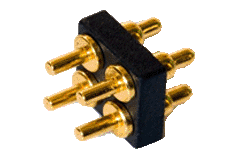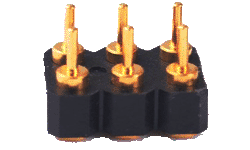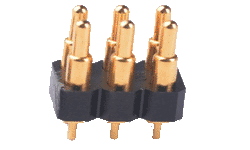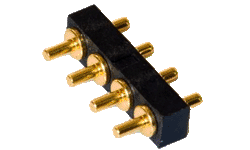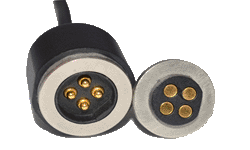2025-3-2 10:37:56
Pogo pins, as precision connector components, are widely used in testing, charging, and data transmission of electronic devices. However, in practical applications, high-temperature environments pose significant challenges to the performance and lifespan of pogo pins. From material selection to structural design, from thermal performance to usage environments, the ability of pogo pins to operate in high-temperature environments may involve multiple aspects. This article provides an in-depth analysis of the high-temperature operational capabilities of pogo pins and offers detailed optimization strategies.
1. Material Selection and Optimization
The material selection for
pogo pin directly affects their ability to operate in high-temperature environments. Common materials include copper alloys and stainless steel, which vary significantly in heat resistance and thermal expansion coefficients. In a smart device testing scenario, optimizing material selection significantly improved the high-temperature operational capabilities of pogo pins.
Surface treatment is another critical factor. Pogo pins typically require surface treatments such as gold or nickel plating to enhance conductivity and corrosion resistance. However, improper surface treatment can reduce heat resistance, affecting their stability in high-temperature environments. In a charging device, optimizing surface treatment processes extended the lifespan of pogo pins in high-temperature environments.
The thermal expansion coefficient of materials is also a significant factor affecting high-temperature performance. Differences in thermal expansion coefficients between materials can generate thermal stress in high-temperature environments, impacting the mechanical and electrical performance of pogo pins. In a high-precision testing device, selecting materials with matched thermal expansion coefficients extended the lifespan of pogo pins in high-temperature environments.
2. Structural Design Optimization
The structural design of pogo pins directly affects their high-temperature performance. Poor design can lead to localized stress concentration, affecting lifespan. In a smart device testing scenario, optimizing the structural design of pogo pins significantly improved their high-temperature operational capabilities.
The design of contact points is also an important factor. The shape, size, and position of contact points directly impact high-temperature performance. In a charging device, optimizing contact point design extended the lifespan of pogo pins in high-temperature environments.
The design of connectors is another critical factor. The structural design of connectors directly affects the high-temperature performance of pogo pins. In a high-precision testing device, optimizing connector design extended the lifespan of pogo pins in high-temperature environments.
3. Thermal Performance Optimization
Thermal performance is a significant factor affecting the high-temperature capabilities of pogo pins. Poor thermal performance can cause pogo pins to overheat in high-temperature environments, affecting their mechanical and electrical performance. In a smart device testing scenario, optimizing thermal design resolved the issue of pogo pins overheating in high-temperature environments.
The thermal conductivity of materials is another critical factor. Materials with low thermal conductivity can lead to poor thermal performance, affecting high-temperature capabilities. In a charging device, selecting materials with high thermal conductivity improved the high-temperature performance of pogo pins.
The design of thermal structures is also an important factor. Proper thermal structure design can enhance the thermal performance of pogo pins, improving their high-temperature capabilities. In a high-precision testing device, optimizing thermal structure design resolved the issue of pogo pins overheating in high-temperature environments.
4. Usage Environment Control
Ambient temperature control is key to ensuring the normal operation of pogo pins in high-temperature environments. Using temperature control equipment, the ambient temperature is maintained within a reasonable range. In an automated production line, controlling ambient temperature significantly extended the lifespan of pogo pins.
Ambient humidity control is also an important factor. Excessively high humidity can cause corrosion, affecting the high-temperature performance of pogo pins. In an electronic device testing scenario, controlling ambient humidity extended the lifespan of pogo pins in high-temperature environments.
Environmental cleanliness is another critical factor. Contaminants such as dust and oil can cause poor contact, affecting the high-temperature performance of pogo pins. In a high-precision testing device, improving environmental cleanliness extended the lifespan of pogo pins in high-temperature environments.
5. Maintenance Strategies
Regular cleaning is an important measure to extend the lifespan of pogo pins in high-temperature environments. Use specialized cleaning tools and solutions, avoiding abrasive or corrosive cleaners. In a high-precision inspection system, regular cleaning of pogo pins significantly extended their lifespan in high-temperature environments.
Regular inspection is another critical measure. Periodically check the contact status and surface wear of pogo pins to identify and address issues promptly. In an automated production line, regular inspections extended the lifespan of pogo pins in high-temperature environments.
Regular replacement is an effective way to extend lifespan. Based on usage frequency and application requirements, replace pogo pins periodically to avoid failures caused by aging. In a high-frequency usage environment, regular replacement of pogo pins significantly extended their lifespan in high-temperature environments.
6. Future Development Trends
Intelligence is the direction for extending the lifespan of pogo pins in high-temperature environments. By integrating sensors and intelligent algorithms, monitor the status of pogo pins in real time and provide early warnings and solutions. In a smart device testing scenario, intelligent applications significantly extended the lifespan of pogo pins in high-temperature environments.
Miniaturization is another important trend. As electronic devices move toward smaller and more portable designs, pogo pins are also evolving toward smaller sizes and higher performance. In a portable testing device, miniaturized design extended the lifespan of pogo pins in high-temperature environments.
Multifunctional integration is the future direction for pogo pins. By integrating multiple functional modules, improve the performance and reliability of pogo pins. In a multifunctional testing device, multifunctional integration design significantly extended the lifespan of pogo pins in high-temperature environments.
The ability of pogo pins to operate in high-temperature environments involves material selection, structural design, thermal performance, usage environments, and maintenance. Through systematic optimization and strategy implementation, not only can the high-temperature performance of pogo pins be improved, but their lifespan can also be extended, enhancing system stability and reliability. With continuous technological advancements, the design and manufacturing of pogo pins will continue to be optimized, providing stronger connectivity for electronic devices. In the future, the deep integration of pogo pins with new materials and processes


